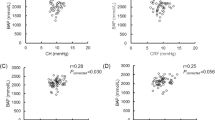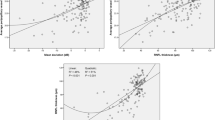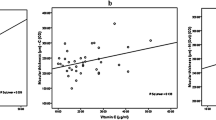Abstract
Purpose
To investigate the role of oxidative stress and lipid peroxidation in the pathogenesis of primary open-angle glaucoma (POAG).
Materials and methods
The activities of myeloperoxidase (MPO), catalase (CAT), and the levels of plasma malondialdehyde (MDA) were measured in 40 (15 men and 25 women) patients with POAG and 60 (30 men and 30 women) healthy controls.
Results
There was no significant difference in the activities of CAT and MPO between the POAG patients and the controls. However, the plasma MDA level was significantly higher in patients than the controls.
Conclusion
The results of this preliminary study suggest that the possible alterations of plasma MDA levels may be associated with the pathogenesis of POAG, but further research is needed to understand the role of oxidative damage in this important disorder of aging.
Similar content being viewed by others
Introduction
Primary open-angle glaucoma (POAG), the most common form of glaucoma, is a slowly progressive atrophy of the optic nerve, characterized by loss of peripheral visual function and is usually associated with elevated intraocular pressure. Glaucoma is the second leading cause of vision loss in the world. The number of people with primary glaucoma is estimated at nearly 66.8 million by the year 2000, with 6.7 million of them suffering from bilateral blindness.1 The molecular basis of POAG is mostly unknown. Several theories of its pathogenesis have been proposed, including mechanic and ischaemic ones.
Oxidation–reduction mechanisms have special importance in the eye. Oxidative damage can result in a number of molecular changes that contribute to the development of glaucoma, cataract, and other eye diseases.2, 3 If the free radical theory of aging is applied to the eye, an altered antioxidant/oxidant balance should be evident for age-related ocular diseases, such as age-related macular degeneration, cataract, and glaucoma.4
All of the studies investigating the relation between POAG, oxidant stress, and antioxidant systems were carried out at the tissue level. We could not find any study concerning systemic antioxidant enzyme level in published reports. Owing to this, the exact role of the levels of blood antioxidant substances in disease development and progression remains to be fully elucidated.
In this study, myeloperoxidase (MPO) and catalase (CAT) enzyme activities that belong to the antioxidant defence system, and malondialdehyde (MDA), the by-product of lipid peroxidation, plasma levels were measured in POAG patients. It was investigated whether the spoilt balance between oxidant stress–antioxidant defence systems occurring at the cell level was reflected on the blood level or not.
Materials and methods
This study was performed with 40 POAG patients whose ages range from 40 to 83 years (15 men and 25 women) attending Mersin University Faculty of Medicine Department of Ophthalmology. A total of 60 healthy subjects (30 men and 30 women; age range: 45–73 years), who visited our hospital for an annual check-up, were considered as the control group. Cases with chronic diseases such as diabetes mellitus, systemic hypertension, chronic anaemia, thyroid function disorders, liver and renal dysfunction, inflammatory arthritis, heart failure, and patients under drug treatment were excluded from the study. All of the subjects were nonsmokers and none of them was consuming alcohol. Only POAG cases were included in the study, and primary angle closure glaucoma, normotensive glaucoma, and ocular hypertension cases were excluded from the study. POAG was diagnosed with elevated intraocular pressure, visual field loss, and glaucomatous optic nerve head changes criteria. The follow-up period of the cases in the study group ranged from 6 months to 20 years. None of the study group and control cases had any other age-related eye disease. During the examination, Lens Opacities Classification System II, which was described by Chylack Jr et al5 and which uses photographic standards for grading cataract type and severity, was used to grade lens status with slit-lamp examination. Both lenses of all cases were graded as having no nuclear, posterior subcapsular, cortical opacities, or having grade I or II opacities
After all subjects gave their informed consent, venous blood samples (10?ml) were taken into ethylenediaminetetraacetic acid-containing test tubes.
Determination of MPO
The determination of sera MPO activity depends on the reduction of o-dianozidine. Reduced o-dianozidine was measured by spectrophotometer at 410?nm.6
Determination of CAT
CAT activity was measured according to the method that was defined by Beutler.7
Principle
CAT catalyses the breakdown of H2O2 to H2O and O2. The rate of decomposition of H2O2 by CAT is measured spectrophotometrically at 230?nm, since H2O2 absorbs light at this wavelength.
Determination of MDA
The MDA level, as an index of lipid peroxidation, was determined by thiobarbituric acid (TBA) reaction according to Yagi. The principle of the method depends on measurement of the pink colour produced by interaction of the barbituric acid with MDA elaborated as a result of lipid peroxidation. 1,1,3,3-Tetraethoxypropane was used as the primary standard.8
Statistical method
CAT and MPO enzyme activities, and MDA levels are given as mean±standard deviation. It was evaluated by ANOVA as to whether there was a significant difference in terms of these variables by forming a general linear model by taking age and gender as covariates. Statistical tests were performed by the SPSS 9.0. P-value<0.05 was considered statistically significant.
Results
The mean age of study group and the control group were 57.3±1.9 and 57.4±1.08 years respectively. Men formed 37.5% in the study group and 50% in the control group. The mean ages of two groups were similar. The mean follow-up period of cases in the study group was 6.23±1.5 years. Demographic features of the two groups are summarized in Table 1.
Erythrocyte MPO, CAT activities, and plasma MDA levels are shown in Table 2. The mean activity (±SEM) of MPO was 0.53±0.05?U/l in the study group and 0.42±0.042?U/l in the controls. There was no significant difference in the MPO activity between the study group and the controls (P=0.329).
Erythrocyte CAT activity was found to be 16346.5±993.9?U/l in POAG patients and 16061.3±1126.6?U/l in control cases. No statistically significant difference was found between the study group and the control group (P=0.919).
Plasma MDA levels were significantly higher in the study group (6.88±0.96?nmol/ml) than the controls (2.94±0.26?nmol/ml) (P=0.0001).
Discussion
The prevalence of POAG is strongly age related.9, 10, 11, 12 Several studies have found a statistically significant increase in intraocular pressure with age.13, 14, 15
There is a general consensus that cumulative oxidative damage is responsible for aging.16 There is an age-related rise in systemic oxidant load, and age-related morbidity is associated with low antioxidant defences.17, 18 Therefore, oxidative damage may play an important role in the pathogenesis of age-related diseases.19
Oxidative damage is a form of tissue injury that is initiated by reactive oxygen species known as free radicals. These reactive molecules can be formed during the course of normal aerobic metabolism or as a result of a particular insult such as light exposure. Complex defence mechanisms against such damage exist in tissues exposed to oxidative stress. However, when defences are inadequate, damage can occur. The final consequence of oxidative damage includes loss of normal structural and functional integrity of cells.20 Within the eye, these damaging reactions have been proposed to be involved in the pathogenesis of age-related diseases.21, 22
Oxidative damage has been hypothesized to play a role in the pathogenesis of glaucoma. As there are high aqueous concentrations of hydrogen peroxide and photochemical reactions in the anterior segment arising from aerobic metabolisms, the trabecular meshwork is exposed to high levels of oxidative stress.16 Aqueous humour is known to contain several active oxidative agents such as hydrogen peroxide and superoxide anion.23, 24 It has been suggested that chronic oxidative insult induced by such agents can compromise trabecular meshwork function25, 26 and subsequently play a role in the pathogenesis POAG. De La Paz and Epstein27 have demonstrated a decline in the specific activity of human trabecular superoxide dismutase, but not CAT, with increasing age, thus supporting the view that oxidative stress may be aetiologically involved in POAG.
In this study in which we investigated the systemic antioxidant enzyme activity in POAG patients, we found no evidence of an association between POAG and systemic enzyme activities of MPO, CAT (P=0.329 for MPO, P=0.919 for CAT). However, a statistically significant relationship was found between the presence of POAG and plasma MDA levels (P=0.0001). The plasma MDA level, a by-product of lipid peroxidation, is a reliable and commonly used biomarker of the overall lipid peroxidation. Our finding of increased plasma MDA levels in POAG patients is not only consistent with the role of oxidative stress in POAG but also supports the idea that plasma MDA levels may be used as a marker of oxidative stress on a group basis.
Clearly, additional research is needed for further evaluation of the role of oxidative stress in POAG. We conclude from these results that systemic antioxidant enzyme activities evaluated in the red blood cells of individuals with POAG are not useful correlates of disease. There is no evidence for an underlying systemic oxidative stress, measured by antioxidant enzyme activities in red blood cells of patients, in POAG.
References
Quigley HA . Number of people with glaucoma worldwide. Br J Ophthalmol 1996; 80: 389–393.
Augusteyn RC . Protein modification in cataract: possible oxidative mechanisms. In: Duncan G (ed) Mechanisms of Cataract Formation in the Human Lens. Academic Press: (London), 1981, pp 71–116.
Berman ER . Biochemistry of the Eye. Plenum Press: New York, 1991.
Webb M . Toxicological significance of metallothionein. Exp Suppl 1987; 52: 109–134.
Chylack Jr LT, Leske MC, McCarthy D, Khu P, Kashiwagi T, Sperduto R . Lens opacities classification system II (LOCS II). Arch Ophthalmol 1989; 107: 991–997.
Golowich SP, Kaplan SD . Methods in Enzymology. Academic Press Inc.: New York, 1955.
Beutler E . Glutathione. In: Beutler E (ed). Red Cell Metabolism: A Manual of Biochemical Methods. Grune and Stratton: New York, 1975, pp 105–107.
Yagi K . Lipid peroxides and related radicals in clinical medicine. In: Armstrong D (ed). Free Radicals in Diagnostic Medicine. Plenum Press: New York, 1994, pp 1–15.
Rochtchina E, Mitchell P . Projected number of Australians with glaucoma in 2000 and 2030. Clin Exp Ophthalmol 2000; 28: 146–148.
Mitchell P, Smith W, Attebo K, Healey PR . Prevalence of open-angle glaucoma in Australia. The Blue Mountains Eye Study. Ophthalmology 1996; 103: 1661–1669.
Dielemans I, Vingerling JR, Wolfs RC, Hofman A, Grobbee DE, de Jong PT . The prevalence of primary open-angle glaucoma in a population-based study in the Netherlands. The Rotterdam Study. Ophthalmology 1994; 101: 1851–1855.
Leske MC, Connell AM, Schachat AP, Hyman L . The Barbados Eye Study. Prevalence of open angle glaucoma. Arch Ophthalmol 1994; 112: 821–829.
Bonomi L, Marchini G, Marraffa M, Bernardi P, De Franco I, Perfetti S et al. Prevalence of glaucoma and intraocular pressure distribution in a defined population. The Egna-Neumarkt Study. Ophthalmology 1998; 105: 209–215.
Wu SY, Leske MC . Associations with intraocular pressure in the Barbados Eye Study. Arch Ophthalmol 1997; 115: 1572–1576.
David R, Zangwill L, Stone D, Yassur Y . Epidemiology of intraocular pressure in a population screened for glaucoma. Br J Ophthalmol 1987; 71: 766–771.
Stephen B, Koh H, Phil M, Henson D, Boulton M . The role of oxidative stress in the pathogenesis of age-related macular degeneration. Surv Ophthalmol 2000; 45: 115–134.
Paolisso G, Tagliamonte MR, Rizzo MR, Manzella D, Gambardella A, Varricchio M . Oxidative stress and advancing age: results in healthy centenarians. J Am Geriatr Soc 1998; 46: 833–838.
Rondanelli M, Melzi dEril GV, Anesi A, Ferrari E . Altered oxidative stress in healthy old subjects. Aging Clin Exp Res 1997; 9: 221–223.
Delcourt C, Cristol JP, Léger CL, Descomps B, Papoz L . Associations of antioxidant enzymes with cataract and age-related macular degeneration. The POLA Study. Ophthalmology 1999; 106: 215–222.
De La Paz MA, Zhang J, Fridovich I . Red blood cell antioxidant enzymes in age-related macular degeneration. Br J Ophthalmol 1996; 80: 445–450.
Young RW . Solar radiation and age-related macular degeneration. Surv Ophthalmol 1998; 32: 252–269.
De La Paz MA, Anderson RE . Regional and age-related variation in susceptibility of the human retina to lipid peroxidation. Invest Ophthalmol Vis Sci 1992; 33: 3497–3499.
Spector A, Garner WH . Hydrogen peroxide and human cataract. Exp Eye Res 1981; 33: 673–681.
Bhuyan KC, Bhuyan DG . Regulation of hydrogen peroxide in eye humors: Effect of 3-amino-1H-1,2,4-triazole on catalase and glutathione peroxidase of rabbit eye. Biochim Biophys Acta 1977; 497: 641–651.
Nguyen KPV, Chung ML, Anderson PJ, Johnson M, Epstein DL . Hydrogen peroxide removal by the calf aqueous outflow pathway. Invest Ophthalmol Vis Sci 1988; 29: 976–981.
Kahn MG, Giblin FJ, Epstein DL . Glutathione in calf trabecular meshwork and its relation to aqueous humor outflow facility. Invest Ophthalmol Vis Sci 1983; 24: 1283–1287.
De La Paz MA, Epstein DL . Effect of age on superoxide dismutase activity of human trabecular meshwork. Invest Ophthalmol Vis Sci 1996; 37: 1849–1853.
Author information
Authors and Affiliations
Corresponding author
Rights and permissions
About this article
Cite this article
Yıldırım, Ö., Ateş, N., Ercan, B. et al. Role of oxidative stress enzymes in open-angle glaucoma. Eye 19, 580–583 (2005). https://doi.org/10.1038/sj.eye.6701565
Received:
Accepted:
Published:
Issue Date:
DOI: https://doi.org/10.1038/sj.eye.6701565
Keywords
This article is cited by
-
Association between systemic oxidative stress and visual field damage in open-angle glaucoma
Scientific Reports (2016)
-
Total antioxidant level is correlated with intra-ocular pressure in patients with primary angle closure glaucoma
BMC Research Notes (2014)
-
Edible Seaweed, Eisenia bicyclis, Protects Retinal Ganglion Cells Death Caused by Oxidative Stress
Marine Biotechnology (2012)
-
Glaukom und oxidativer Stress
Der Ophthalmologe (2006)



